TPMS Acura ILX 2016 Owner's Guide
[x] Cancel search | Manufacturer: ACURA, Model Year: 2016, Model line: ILX, Model: Acura ILX 2016Pages: 78, PDF Size: 20.92 MB
Page 4 of 78
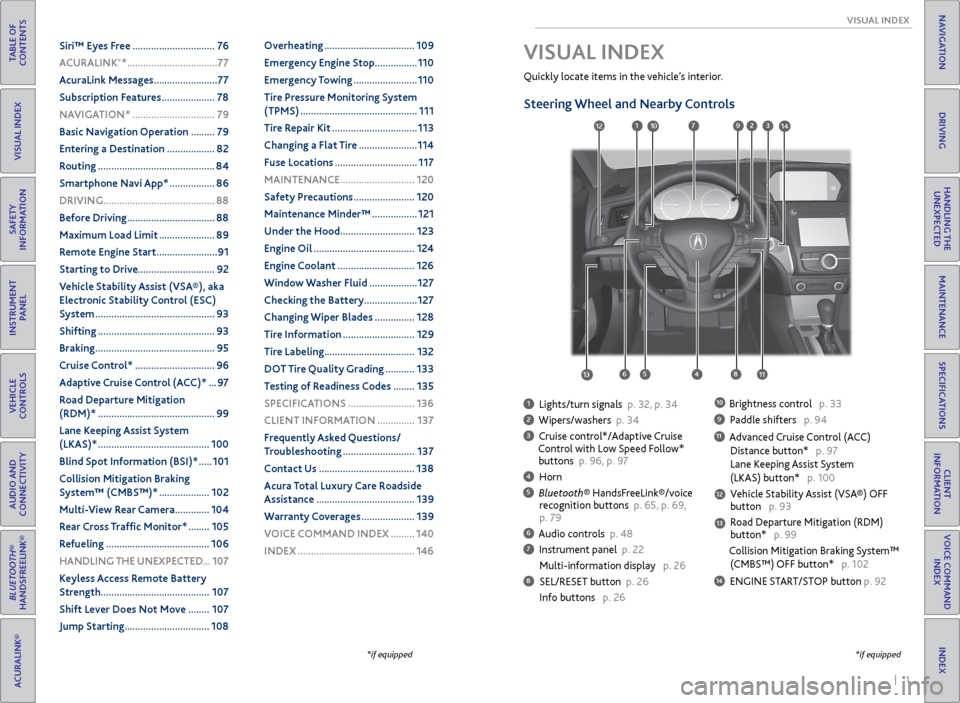
| 1
VISUAL INDEX
INDEX
VOICE COMMAND
INDEX
CLIENT
INFORMATION
SPECIFICATIONS
MAINTENANCE
HANDLING THE UNEXPECTED
DRIVING
NAVIGATION
TABLE OF
CONTENTS
VISUAL INDEX
SAFETY
INFORMATION
INSTRUMENT PANEL
VEHICLE
CONTROLS
AUDIO AND
CONNECTIVITY
BLUETOOTH®
HANDSFREELINK®
ACURALINK®
1 Lights/turn signals p. 32, p. 34
2 Wipers/washers p. 34
3 Cruise control*/Adaptive Cruise
Control with Low Speed Follow*
buttons p. 96, p. 97
4 Horn
5 Bluetooth® HandsFreeLink®/voice recognition buttons p. 65, p. 69,
p. 79
6 Audio controls p. 48
7 Instrument panel p. 22
Multi-information display p. 26
8 SEL/RESET button p. 26
Info buttons p. 26
Quickly locate items in the vehicle’s interior.
Steering Wheel and Nearby Controls
Brightness control p. 33
9 Paddle shifters p. 94
11 Advanced Cruise Control (ACC)
Distance button* p. 97
Lane Keeping Assist System
(LKAS) button* p. 100
Vehicle Stability Assist (VSA®) OFF
button p. 93
Road Departure Mitigation (RDM)
button* p. 99
Collision Mitigation Braking System™
(CMBS™) OFF button* p. 102
14 ENGINE START/STOP button p. 92
10
VISUAL INDEX
*if equipped
127
4
12
6
14
*if equipped
58
9
12
13
13
103
11
Siri™ Eyes Free ............................... 76
A CURALINK
®* .................................. 77
AcuraLink Messages ........................ 77
Subscription Features .................... 78
NAVIGATION* ............................... 79
Basic Navigation Operation ......... 79
Entering a Destination .................. 82
Routing ............................................ 84
Smartphone Navi App* ................. 86
DRIVING .......................................... 88
Before Driving ................................. 88
Maximum Load Limit ..................... 89
Remote Engine Start ....................... 91
Starting to Drive ............................. 92
Vehicle Stability Assist (VSA®), aka
Electronic Stability Control (ESC)
System ............................................. 93
Shifting ............................................ 93
Braking ............................................. 95
Cruise Control* .............................. 96
Adaptive Cruise Control (ACC)* ... 97
Road Departure Mitigation
(RDM)* ............................................ 99
Lane Keeping Assist System
(LKAS)* .......................................... 100
Blind Spot Information (BSI)* ..... 101
Collision Mitigation Braking
System™ (CMBS™)* ................... 102
Multi-View Rear Camera ............. 104
Rear Cross Traffic Monitor* ........ 105
Refueling ....................................... 106
HANDLING THE UNEXPECTED ...107
Keyless Access Remote Battery
Strength ......................................... 107
Shift Lever Does Not Move ........ 107
Jump Starting ................................ 108Overheating ..................................
109
Emergency Engine Stop ................ 110
Emergency Towing ........................ 110
Tire Pressure Monitoring System
(TPMS) ............................................ 111
Tire Repair Kit ................................ 113
Changing a Flat Tire ...................... 114
Fuse Locations ............................... 117
MAINTENANCE ............................ 120
Safety Precautions ....................... 120
Maintenance Minder™ ................. 121
Under the Hood ............................ 123
Engine Oil ...................................... 124
Engine Coolant ............................. 126
Window Washer Fluid .................. 127
Checking the Battery .................... 127
Changing Wiper Blades ............... 128
Tire Information ........................... 129
Tire Labeling .................................. 132
DOT Tire Quality Grading ........... 133
Testing of Readiness Codes ........ 135
SPECIFICATIONS ......................... 136
CLIENT INFORMATION .............. 137
Frequently Asked Questions/
Troubleshooting ........................... 137
Contact Us .................................... 138
Acura Total Luxury Care Roadside
Assistance ..................................... 139
Warranty Coverages .................... 139
V OICE COMMAND INDEX ......... 140
INDEX ............................................ 146
Page 15 of 78
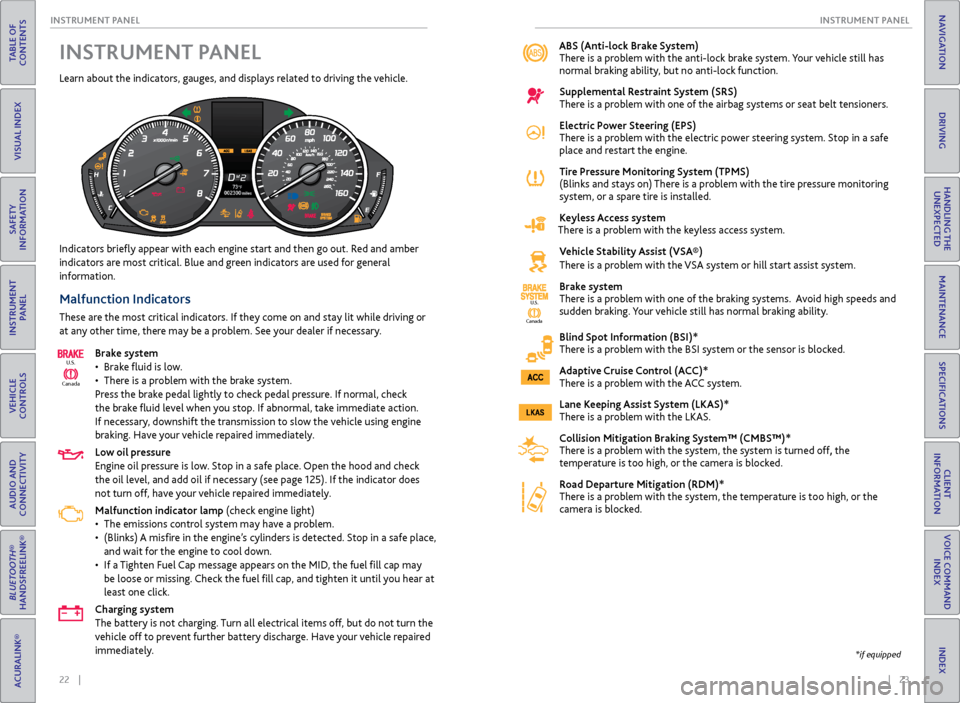
22 || 23
INSTRUMENT P
ANEL
INSTRUMENT P ANEL
TABLE OF
CONTENTS
INDEX
VISUAL INDEX
VOICE COMMAND INDEX
SAFETY
INFORMATION
CLIENT
INFORMATION
INSTRUMENT PANEL
SPECIFICATIONS
VEHICLE
CONTROLS
MAINTENANCE
AUDIO AND
CONNECTIVITY
HANDLING THE UNEXPECTED
BLUETOOTH®
HANDSFREELINK®
DRIVING
ACURALINK®
NAVIGATION
ABS (Anti-lock Brake System)
There is a problem with the anti-lock brake system. Your vehicle still has
normal braking ability, but no anti-lock function.
Supplemental Restraint System (SRS)
There is a problem with one of the airbag systems or seat belt tensioners.
Electric Power Steering (EPS)
There is a problem with the electric power steering system. Stop in a safe
place and restart the engine.
Tire Pressure Monitoring System (TPMS)
(Blinks and stays on) There is a problem with the tire pressure monitoring
system, or a spare tire is installed.
Keyless Access system
There is a problem with the keyless access system.
Vehicle Stability Assist (VSA®)
There is a problem with the VSA system or hill start assist system.
Brake system
There is a problem with one of the braking systems. Avoid high speeds and
sudden braking. Your vehicle still has normal braking ability.
Blind Spot Information (BSI)*
There is a problem with the BSI system or the sensor is blocked.
Adaptive Cruise Control (ACC)*
There is a problem with the ACC system.
Lane Keeping Assist System (LKAS)*
There is a problem with the LKAS.
Collision Mitigation Braking System™ (CMBS™)*
There is a problem with the system, the system is turned off, the
temperature is too high, or the camera is blocked.
Road Departure Mitigation (RDM)*
There is a problem with the system, the temperature is too high, or the
camera is blocked.
Indicators briefly appear with each engine start and then go out. Red and amber
indicators are most critical. Blue and green indicators are used for general
information.
Malfunction Indicators
These are the most critical indicators. If they come on and stay lit while driving or
at any other time, there may be a problem. See your dealer if necessary.
Brake system
• Brake fluid is low.
• There is a problem with the brake system.
Press the brake pedal lightly to check pedal pressure. If normal, check
the brake fluid level when you stop. If abnormal, take immediate action.
If necessary, downshift the transmission to slow the vehicle using engine
braking. Have your vehicle repaired immediately.
Low oil pressure
Engine oil pressure is low. Stop in a safe place. Open the hood and check
the oil level, and add oil if necessary (see page 125). If the indicator does
not turn off, have your vehicle repaired immediately.
Malfunction indicator lamp (check engine light)
• The emissions control system may have a problem.
• (Blinks) A misfire in the engine’s cylinders is detected. Stop in a safe place,
and wait for the engine to cool down.
• If a Tighten Fuel Cap message appears on the MID, the fuel fill cap may
be loose or missing. Check the fuel fill cap, and tighten it until you hear at
least one click.
Charging system
The battery is not charging. Turn all electrical items off, but do not turn the
vehicle off to prevent further battery discharge. Have your vehicle repaired
immediately.
Ca nada
U.S.
INSTRUMENT P
ANEL
Learn about the indicators, gauges, and displays related to driving the vehicle.
Canada
U.S.
*if equipped
Page 59 of 78
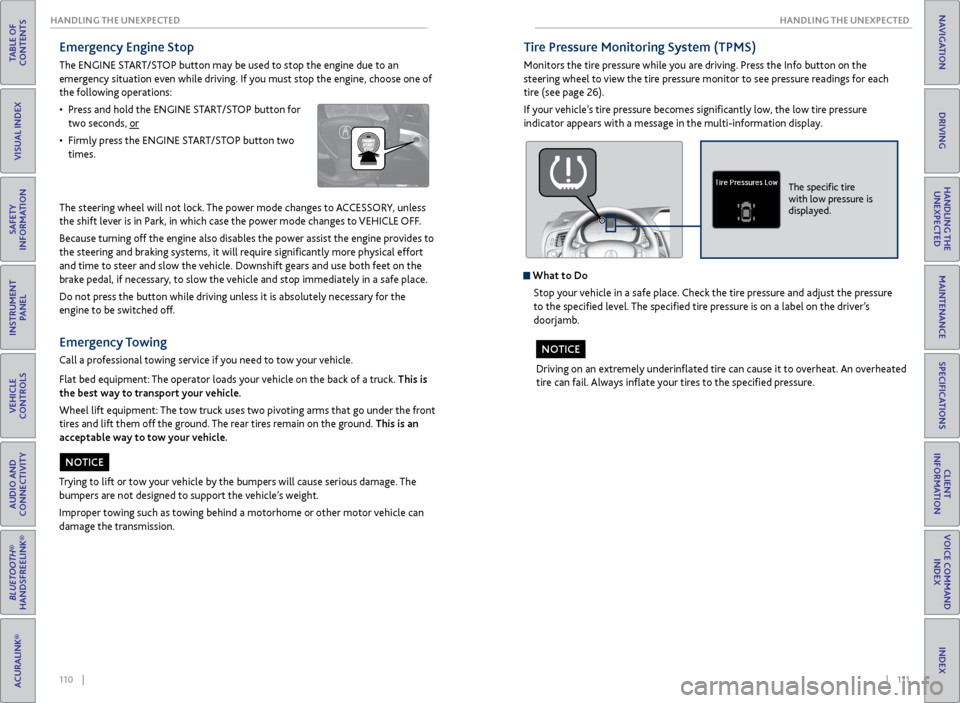
110 || 111
HANDLING THE UNEXPECTED
HANDLING THE UNEXPECTED
TABLE OF
CONTENTS
INDEX
VISUAL INDEX
VOICE COMMAND INDEX
SAFETY
INFORMATION
CLIENT
INFORMATION
INSTRUMENT PANEL
SPECIFICATIONS
VEHICLE
CONTROLS
MAINTENANCE
AUDIO AND
CONNECTIVITY
HANDLING THE UNEXPECTED
BLUETOOTH®
HANDSFREELINK®
DRIVING
ACURALINK®
NAVIGATION
Emergency Engine Stop
The ENGINE START/STOP button may be used to stop the engine due to an
emergency situation even while driving. If you must stop the engine, choose one of
the following operations:
• Press and hold the ENGINE START/STOP button for
two seconds, or
• Firmly press the ENGINE START/STOP button two
times.
The steering wheel will not lock. The power mode changes to ACCESSORY, unless
the shift lever is in Park, in which case the power mode changes to VEHICLE OFF.
Because turning off the engine also disables the power assist the engine provides to
the steering and braking systems, it will require significantly more physical effort
and time to steer and slow the vehicle. Downshift gears and use both feet on the
brake pedal, if necessary, to slow the vehicle and stop immediately in a safe place.
Do not press the button while driving unless it is absolutely necessary for the
engine to be switched off.
Emergency Towing
Call a professional towing service if you need to tow your vehicle.
Flat bed equipment: The operator loads your vehicle on the back of a truck. This is
the best way to transport your vehicle.
Wheel lift equipment: The tow truck uses two pivoting arms that go under the front
tires and lift them off the ground. The rear tires remain on the ground. This is an
acceptable way to tow your vehicle.
Trying to lift or tow your vehicle by the bumpers will cause serious damage. The
bumpers are not designed to support the vehicle’s weight.
Improper towing such as towing behind a motorhome or other motor vehicle can
damage the transmission.
NOTICE
Tire Pressure Monitoring System (TPMS)
Monitors the tire pressure while you are driving. Press the Info button on the
steering wheel to view the tire pressure monitor to see pressure readings for each
tire (see page 26).
If your vehicle’s tire pressure becomes significantly low, the low tire pressure
indicator appears with a message in the multi-information display.
What to Do
Stop your vehicle in a safe place. Check the tire pressure and adjust the pressure
to the specified level. The specified tire pressure is on a label on the driver’s
doorjamb.
Driving on an extremely underinflated tire can cause it to overheat. An overheated
tire can fail. Always inflate your tires to the specified pressure.
NOTICE
The specific tire
with low pressure is
displayed.
Page 60 of 78
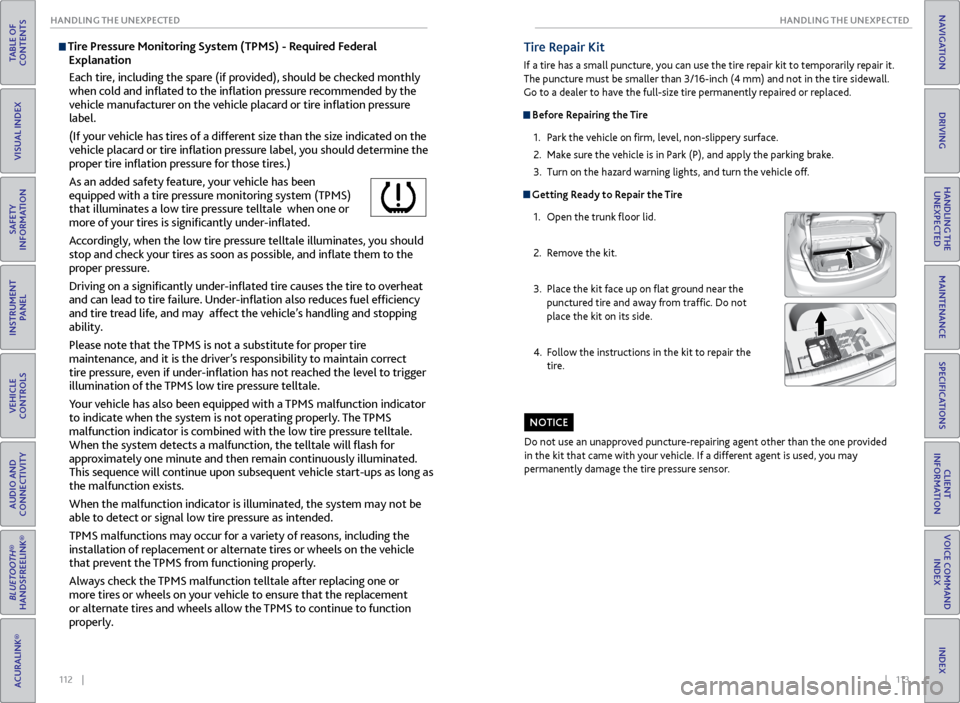
112 || 113
HANDLING THE UNEXPECTED
HANDLING THE UNEXPECTED
TABLE OF
CONTENTS
INDEX
VISUAL INDEX
VOICE COMMAND INDEX
SAFETY
INFORMATION
CLIENT
INFORMATION
INSTRUMENT PANEL
SPECIFICATIONS
VEHICLE
CONTROLS
MAINTENANCE
AUDIO AND
CONNECTIVITY
HANDLING THE UNEXPECTED
BLUETOOTH®
HANDSFREELINK®
DRIVING
ACURALINK®
NAVIGATION
Tire Pressure Monitoring System (TPMS) - Required Federal
Explanation
Each tire, including the spare (if provided), should be checked monthly
when cold and inflated to the inflation pressure recommended by the
vehicle manufacturer on the vehicle placard or tire inflation pressure
label.
(If your vehicle has tires of a different size than the size indicated on the
vehicle placard or tire inflation pressure label, you should determine the
proper tire inflation pressure for those tires.)
As an added safety feature, your vehicle has been
equipped with a tire pressure monitoring system (TPMS)
that illuminates a low tire pressure telltale when one or
more of your tires is significantly under-inflated.
Accordingly, when the low tire pressure telltale illuminates, you should
stop and check your tires as soon as possible, and inflate them to the
proper pressure.
Driving on a significantly under-inflated tire causes the tire to overheat
and can lead to tire failure. Under-inflation also reduces fuel efficiency
and tire tread life, and may affect the vehicle’s handling and stopping
ability.
Please note that the TPMS is not a substitute for proper tire
maintenance, and it is the driver’s responsibility to maintain correct
tire pressure, even if under-inflation has not reached the level to trigger
illumination of the TPMS low tire pressure telltale.
Your vehicle has also been equipped with a TPMS malfunction indicator
to indicate when the system is not operating properly. The TPMS
malfunction indicator is combined with the low tire pressure telltale.
When the system detects a malfunction, the telltale will flash for
approximately one minute and then remain continuously illuminated.
This sequence will continue upon subsequent vehicle start-ups as long as
the malfunction exists.
When the malfunction indicator is illuminated, the system may not be
able to detect or signal low tire pressure as intended.
TPMS malfunctions may occur for a variety of reasons, including the
installation of replacement or alternate tires or wheels on the vehicle
that prevent the TPMS from functioning properly.
Always check the TPMS malfunction telltale after replacing one or
more tires or wheels on your vehicle to ensure that the replacement
or alternate tires and wheels allow the TPMS to continue to function
properly.Tire Repair Kit
If a tire has a small puncture, you can use the tire repair kit to temporarily repair it.
The puncture must be smaller than 3/16-inch (4 mm) and not in the tire sidewall.
Go to a dealer to have the full-size tire permanently repaired or replaced.
Before Repairing the Tire
1. Park the vehicle on firm, level, non-slippery surface.
2. Make sure the vehicle is in Park (P), and apply the parking brake.
3. Turn on the hazard warning lights, and turn the vehicle off.
Getting Ready to Repair the Tire
1. Open the trunk floor lid.
2. Remove the kit.
3. Place the kit face up on flat ground near the
punctured tire and away from traffic. Do not
place the kit on its side.
4. Follow the instructions in the kit to repair the
tire.
Do not use an unapproved puncture-repairing agent other than the one provided
in the kit that came with your vehicle. If a different agent is used, you may
permanently damage the tire pressure sensor.
NOTICE
Page 69 of 78
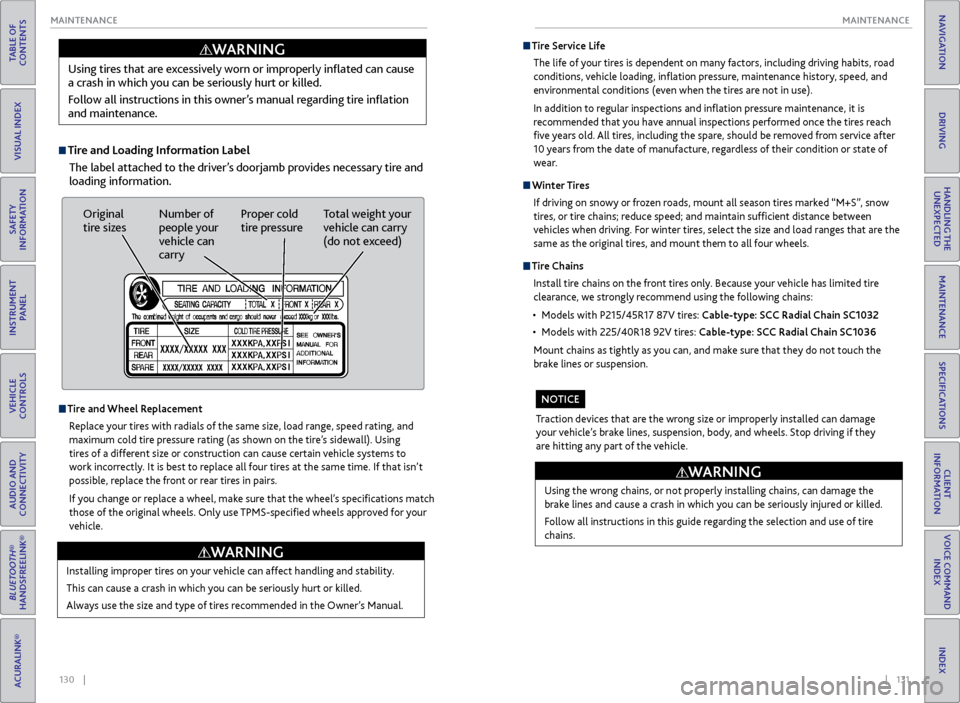
130 || 131
MAINTENANCE
MAINTENANCE
TABLE OF
CONTENTS
INDEX
VISUAL INDEX
VOICE COMMAND INDEX
SAFETY
INFORMATION
CLIENT
INFORMATION
INSTRUMENT PANEL
SPECIFICATIONS
VEHICLE
CONTROLS
MAINTENANCE
AUDIO AND
CONNECTIVITY
HANDLING THE UNEXPECTED
BLUETOOTH®
HANDSFREELINK®
DRIVING
ACURALINK®
NAVIGATION
Tire and Loading Information Label
The label attached to the driver’s doorjamb provides necessary tire and
loading information.
Using tires that are excessively worn or improperly inflated can cause
a crash in which you can be seriously hurt or killed.
Follow all instructions in this owner’s manual regarding tire inflation
and maintenance.
WARNING
Original
tire sizes
Number of
people your
vehicle can
carry Proper cold
tire pressure
Total weight your
vehicle can carry
(do not exceed)
Tire and Wheel Replacement
Replace your tires with radials of the same size, load range, speed rating, and
maximum cold tire pressure rating (as shown on the tire’s sidewall). Using
tires of a different size or construction can cause certain vehicle systems to
work incorrectly. It is best to replace all four tires at the same time. If that isn’t
possible, replace the front or rear tires in pairs.
If you change or replace a wheel, make sure that the wheel’s specifications match
those of the original wheels. Only use TPMS-specified wheels approved for your
vehicle.
Installing improper tires on your vehicle can affect handling and stability.
This can cause a crash in which you can be seriously hurt or killed.
Always use the size and type of tires recommended in the Owner’s Manual.
WARNING
Tire Service Life
The life of your tires is dependent on many factors, including driving habits, road
conditions, vehicle loading, inflation pressure, maintenance history, speed, and
environmental conditions (even when the tires are not in use).
In addition to regular inspections and inflation pressure maintenance, it is
recommended that you have annual inspections performed once the tires reach
five years old. All tires, including the spare, should be removed from service after
10 years from the date of manufacture, regardless of their condition or state of
wear.
Winter Tires
If driving on snowy or frozen roads, mount all season tires marked “M+S”, snow
tires, or tire chains; reduce speed; and maintain sufficient distance between
vehicles when driving. For winter tires, select the size and load ranges that are the
same as the original tires, and mount them to all four wheels.
Tire Chains
Install tire chains on the front tires only. Because your vehicle has limited tire
clearance, we strongly recommend using the following chains:
• Models with P215/45R17 87V tires: Cable-type: SCC Radial Chain SC1032
• Models with 225/40R18 92V tires: Cable-type: SCC Radial Chain SC1036
Mount chains as tightly as you can, and make sure that they do not touch the
brake lines or suspension.
Using the wrong chains, or not properly installing chains, can damage the
brake lines and cause a crash in which you can be seriously injured or killed.
Follow all instructions in this guide regarding the selection and use of tire
chains.
WARNING
Traction devices that are the wrong size or improperly installed can damage
your vehicle’s brake lines, suspension, body, and wheels. Stop driving if they
are hitting any part of the vehicle.
NOTICE
Page 78 of 78
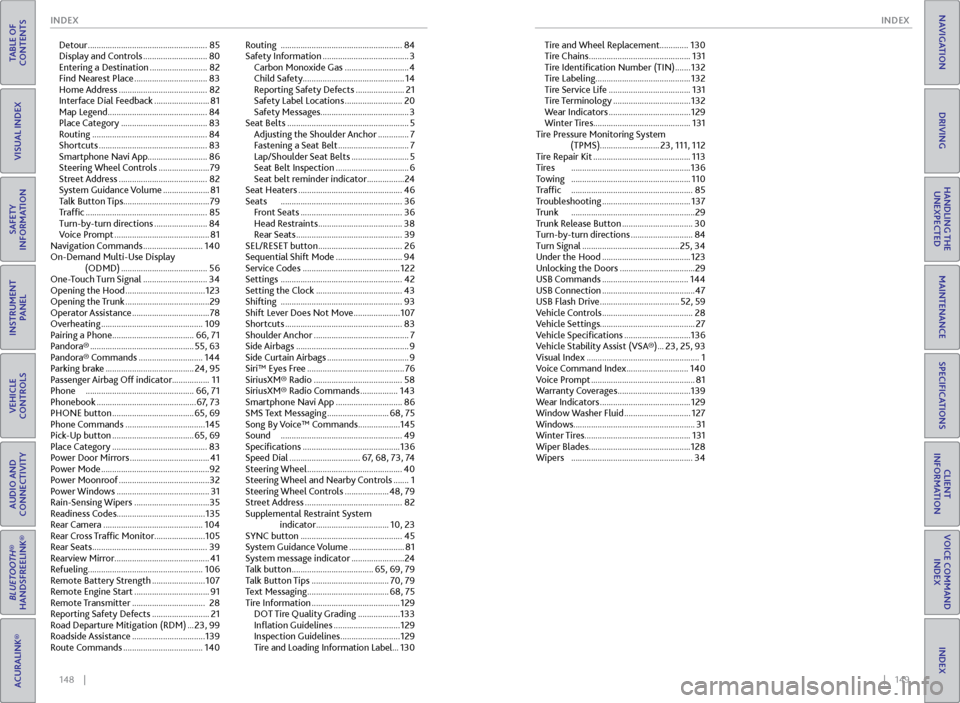
148 || 149
INDEX
INDEX
TABLE OF
CONTENTS
INDEX
VISUAL INDEX
VOICE COMMAND INDEX
SAFETY
INFORMATION
CLIENT
INFORMATION
INSTRUMENT PANEL
SPECIFICATIONS
VEHICLE
CONTROLS
MAINTENANCE
AUDIO AND
CONNECTIVITY
HANDLING THE UNEXPECTED
BLUETOOTH®
HANDSFREELINK®
DRIVING
ACURALINK®
NAVIGATION
Detour ...................................................... 85
Display and Controls ............................. 80
Entering a Destination .......................... 82
Find Nearest Place ................................. 83
Home Address ........................................ 82
Interface Dial Feedback ......................... 81
Map Legend ............................................. 84
Place Category ....................................... 83
Routing .................................................... 84
Shortcuts ................................................. 83
Smartphone Navi App ...........................86
Steering Wheel Controls ....................... 79
Street Address ........................................ 82
System Guidance Volume ..................... 81
Talk Button Tips ....................................... 79
Traffic ....................................................... 85
Turn-by-turn directions ........................ 84
Voice Prompt ........................................... 81
Navigation Commands ........................... 140
On-Demand Multi-Use Display (ODMD) ....................................... 56
One-Touch Turn Signal ............................. 34
Opening the Hood .................................... 123
Opening the Trunk ...................................... 29
Operator Assistance ................................... 78
Overheating .............................................. 109
Pairing a Phone ..................................... 66, 71
Pandora® ............................................... 55, 63
Pandora® Commands ............................. 144
Parking brake ........................................ 24, 95
Passenger Airbag Off indicator .................11
Phone ................................................. 66, 71
Phonebook ............................................. 67, 73
PHONE button ..................................... 65, 69
Phone Commands .................................... 145
Pick-Up button ..................................... 65, 69
Place Category ........................................... 83
Power Door Mirrors .................................... 41
Power Mode ................................................. 92
Power Moonroof ......................................... 32
Power Windows .......................................... 31
Rain-Sensing Wipers .................................. 35
Readiness Codes ........................................ 135
Rear Camera ............................................. 104
Rear Cross Traffic Monitor ....................... 105
Rear Seats .................................................... 39
Rearview Mirror ........................................... 41
Refueling .................................................... 106
Remote Battery Strength ........................ 107
Remote Engine Start .................................. 91
Remote Transmitter ................................. 28
Reporting Safety Defects .......................... 21
Road Departure Mitigation (RDM) ... 23, 99
Roadside Assistance ................................. 139
Route Commands .................................... 140Routing
....................................................... 84
Safety Information ....................................... 3
Carbon Monoxide Gas ............................. 4
Child Safety .............................................. 14
Reporting Safety Defects ...................... 21
Safety Label Locations .......................... 20
Safety Messages ........................................ 3
Seat Belts ....................................................... 5
Adjusting the Shoulder Anchor .............. 7
Fastening a Seat Belt ................................ 7
Lap/Shoulder Seat Belts .......................... 5
Seat Belt Inspection ................................. 6
Seat belt reminder indicator ................. 24
Seat Heaters ............................................... 46
Seats ....................................................... 36
Front Seats .............................................. 36
Head Restraints ...................................... 38
Rear Seats ................................................ 39
SEL/RESET button ...................................... 26
Sequential Shift Mode .............................. 94
Service Codes ............................................ 122
Settings ....................................................... 42
Setting the Clock ....................................... 43
Shifting ....................................................... 93
Shift Lever Does Not Move ..................... 107
Shortcuts ..................................................... 83
Shoulder Anchor ........................................... 7
Side Airbags ................................................... 9
Side Curtain Airbags ..................................... 9
Siri™ Eyes Free ............................................ 76
SiriusXM® Radio ........................................ 58
SiriusXM® Radio Commands ................. 143
Smartphone Navi App .............................. 86
SMS Text Messaging ............................ 68, 75
Song By Voice™ Commands ................... 145
Sound ....................................................... 49
Specifications ............................................ 136
Speed Dial ................................ 67, 68, 73, 74
Steering Wheel ........................................... 40
Steering Wheel and Nearby Controls ....... 1
Steering Wheel Controls .................... 48, 79
Street Address ............................................ 82
Supplemental Restraint System indicator ................................. 10, 23
SYNC button .............................................. 45
System Guidance Volume ......................... 81
System message indicator ........................ 24
Talk button ..................................... 65, 69, 79
Talk Button Tips ................................... 70, 79
Text Messaging ..................................... 68, 75
Tire Information ........................................ 129
DOT Tire Quality Grading ................... 133
Inflation Guidelines .............................. 129
Inspection Guidelines ........................... 129
Tire and Loading Information Label ... 130Tire and Wheel Replacement.............
130
Tire Chains .............................................. 131
Tire Identification Number (TIN) ....... 132
Tire Labeling ........................................... 132
Tire Service Life ..................................... 131
Tire Terminology ................................... 132
Wear Indicators ..................................... 129
Winter Tires ............................................ 131
Tire Pressure Monitoring System (TPMS)........................... 23, 111, 112
Tire Repair Kit ............................................ 113
Tires ...................................................... 136
Towing ...................................................... 110
Traffic ....................................................... 85
Troubleshooting ........................................ 137
Trunk ........................................................ 29
Trunk Release Button ................................ 30
Turn-by-turn directions ............................ 84
Turn Signal ............................................ 25, 34
Under the Hood ........................................ 123
Unlocking the Doors .................................. 29
USB Commands ....................................... 144
USB Connection .......................................... 47
USB Flash Drive .................................... 52, 59
Vehicle Controls
......................................... 28
Vehicle Settings ........................................... 27
Vehicle Specifications .............................. 136
Vehicle Stability Assist (VSA®) ... 23, 25, 93
Visual Index ................................................... 1
Voice Command Index ............................ 140
Voice Prompt ............................................... 81
Warranty Coverages ................................. 139
Wear Indicators ......................................... 129
Window Washer Fluid .............................. 127
Windows ....................................................... 31
Winter Tires ................................................ 131
Wiper Blades .............................................. 128
Wipers ....................................................... 34